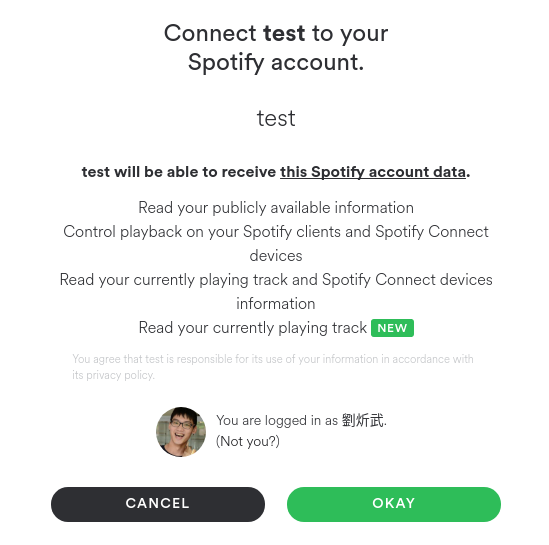Spotify Web API Introduction
Agenda
- About Spotify Web API
-
Steps to build an application
- Explore the functionality of Spotify Web APIs
- Create and register your application
- Learn about authorization
- Understanding the object model
- Let's code!
- Summary

About
Spotify Web API

With Spotify Web API, you could:




Spotify Web API is:
- RESTful
- JSON formatted
- OAuth 2.0
{
"album_type": "album",
"artists": [ {
"name": "Linkin Park",
...
} ],
"name" : "Meteora Live Around The World",
"release_date" : "2012-06-05",
"tracks" : {...},
"uri" : "spotify:album:4flcwtqnLoKZJ2wrCp1aJq",
...
}
GET https://api.spotify.com/v1/albums/4flcwtqnLoKZJ2wrCp1aJq/tracks
POST https://api.spotify.com/v1/users/johnliu55tw/playlists

Steps to
Build an application Using
Spotify Web API

Steps
- Explore the functionality
- Create and register your application
- Learn about authorization
- Understand object model

Spotify Developer
Explore the functionality
- User guides and tutorials
- API reference documents
- Interactive API console
- Examples
- ...

Create your application
- Client ID
- Client Secret
- Redirect URIs

Authorization
- All endpoints
- 3 authorization flows:
OAuth 2.0 (RFC-6749)


Authorization
- Scope
- None (public data only)
- user-library-read
- user-modify-playback-state
- ...
- List of scopes
OAuth 2.0 (RFC-6749)


Object Model
- JSON
- Pagination (paging object)
-
Full/simplified object
- tracks in an album

Object Model
- Common data objects
- Container objects
- Error objects

Object Model
Common data object model
- album
- artist
- track
- ...

Object Model
Example: track
- href key pointing to either self or the full object
- Properties of the object itself (name, id, ...)
- Related objects in simplified version
- artists of a track
- album of a track

{
"album" : {...},
"artists" : [...],
"href" : "https://api.spotify.com/v1/tracks/60a0Rd6pjrkxjPbaKzXjfq",
"id" : "60a0Rd6pjrkxjPbaKzXjfq",
"name" : "In The End",
"popularity" : 86,
"type" : "track",
"uri" : "spotify:track:60a0Rd6pjrkxjPbaKzXjfq",
...
}Object Model
Container object model

Object Model
Paging object
- Offset-based pagination
- items
-
Useful keys:
- next
- previous
- total

{
"href": ".../v1/albums/{id}/tracks?offset=0&limit=2",
"items": [ {
...
} ],
"limit": 2,
"next": ".../v1/albums/{id}/tracks?offset=2&limit=2",
"offset": 0,
"previous": null,
"total": 11
}Object Model
Error object model

Object Model
Authentication error object
- Error occurred during the authentication/authorization
- Follows RFC-6749

{
"error": "invalid_client",
"error_description": "Invalid client secret"
}Object Model
Regular error object
- Error occurred during the regular API requests
- Response status code reference

HTTP/1.1 400 Bad Request
{
"error": {
"status": 400,
"message": "invalid id"
}
}Let's Code!

Let's code!
- Python: Spotipy
Client libraries
RESTful

Let's code!

import spotipy
from spotipy.oauth2 import SpotifyClientCredentials
# My application credentials
CLIENT_ID = 'MY_ID'
CLIENT_SECRET = 'MY SECRET'
# Create a credential manager
cred_manager = SpotifyClientCredentials(client_id=CLIENT_ID,
client_secret=CLIENT_SECRET)
# Ask for new releases
sp = spotipy.Spotify(client_credentials_manager=cred_manager)
paged_albums = sp.new_releases(limit=20, offset=0)['albums']
# Display
for idx, album in enumerate(paged_albums['items'], 1):
artists_name = ', '.join([artist['name'] for artist in album['artists']])
print("{:2d}: {} - {}".format(idx, album['name'], artists_name))
Client Credentials
authorization
Access API
Display

Spotipy
Get new released albums
Spotipy
1: Tell Me You Love Me (Deluxe) - Demi Lovato
2: The Bigger Artist - A Boogie Wit da Hoodie
3: Now (Deluxe) - Shania Twain
4: Younger Now - Miley Cyrus
5: SAVAGE - Tank
6: Seven Days - PARTYNEXTDOOR
7: Vuelve - Daddy Yankee
8: Waterfall - Petit Biscuit, Panama
9: Mean Demeanor - Run The Jewels
10: Deadstar - Smokepurpp
11: In Too Deep - Trippie Redd
12: Buzzin - Alina Baraz
13: Beautiful Trauma - P!nk
14: My Utmost For His Highest - Various Artists
15: Dirtybird Campout West Coast Compilation - Various Artists
16: Take Back Home Girl (Feat. Tori Kelly) - Chris Lane
17: New Energy - Four Tet
18: Our Point Of View - Blue Note All-Stars
19: Dreams and Daggers - Cécile McLorin Salvant
20: Life Is Confusing EP - Langhorne Slim
Get new released albums
import requests
from base64 import b64encode
CLIENT_ID = b'MY_ID'.encode('ascii')
CLIENT_SECRET = b'MY_SECRET'.encode('ascii')
# Request for access token
reqs_body = {'grant_type': 'client_credentials'}
encoded_cred = b64encode(CLIENT_ID + b':' + CLIENT_SECRET).decode('ascii')
header = {'Authorization': "Basic " + encoded_cred}
resp = requests.post("https://accounts.spotify.com/api/token",
data=reqs_body,
headers=header)
resp_json = resp.json()
token = resp_json['access_token']
token_type = resp_json['token_type']
expires_in = resp_json['expires_in']Authorization header
and body
Reqeust for token
Retrieve token from response

Get new released albums
Requests: 1. Retrieve token
# Get new released albums
header = {'Authorization': "Bearer " + token}
params = {'limit': 20, 'offset': 0}
resp = requests.get("https://api.spotify.com/v1/browse/new-releases",
headers=header,
params=params)
obj = resp.json()
for idx, album in enumerate(obj['albums']['items'], 1):
artists_name = ', '.join([artist['name'] for artist in album['artists']])
print("{:2d}: {} - {}".format(idx, album['name'], artists_name))Auth. header with token
Requests parameters
Make the request
Display

Requests: 2. Access API
Get new released albums

Get user information

- Interact with resource owner
- Redirect URI
Get user information

-
/
-
/login
-
/callback
-
/refresh_token
Application endpoints
Get user information

/
/login
Authorization
endpoint
Log in,
authorize access
client ID,
client secret,
scopes,
redirect_uri
Authorization Code: 1. Get the code
Click log in
/callback
code
Get user information

/callback
Token
endpoint
access token,
refresh token
Authorization Code: 2. Get tokens
client ID,
client secret,
code,
redirect_uri
code
/callback
Get user information

Authorization Code: 3. Access API
/callback
access token,
refresh token
Authorization
endpoint
access token
JSON response
token expired
Get user information

Authorization Code: 4. Refresh token
/refresh_token
Authorization
endpoint
client ID,
client secret,
refresh_token
access token
request for refresh
return JSON
Summary
-
Explore the functionality of Spotify Web API
-
Learn about authorization
- Authorization Guide (OAuth 2.0)
- Create and register your application
- Understanding the object model
-
Write and run your code
- Spotipy, Requests, Flask
